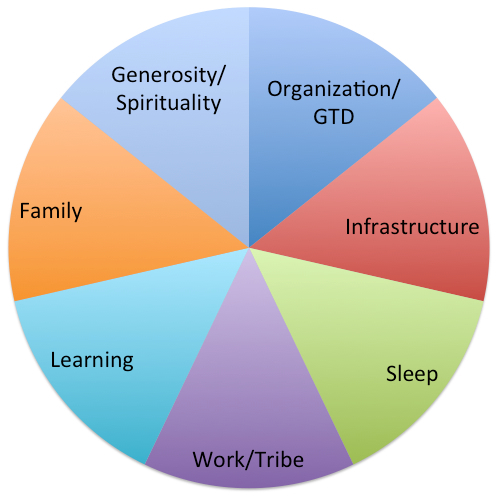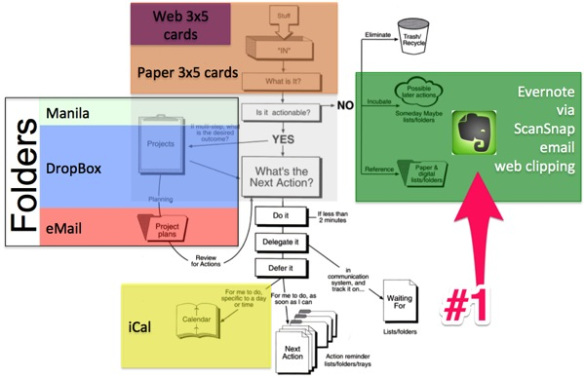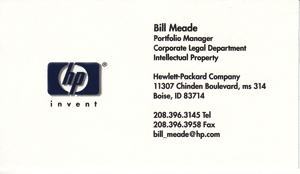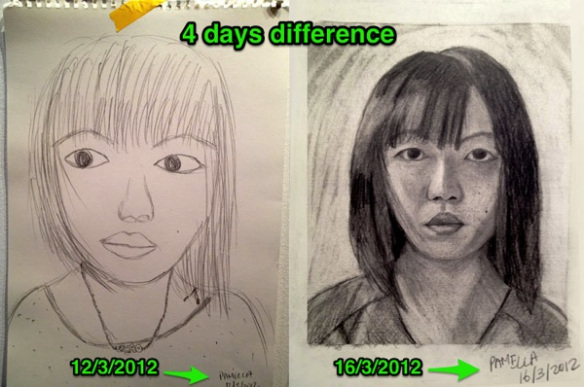Source: imediaconnection.com
Introduction:
Yesterday I posted about Hallowell’s 2005 “Overloaded Circuits: Why Smart People Under Perform” and how it reminded me of Dietrich Dorner THE LOGIC OF FAILURE in how central the role of fear is in our mental functioning.
Purpose of this post is to for me to articulate for myself, how I’ve “built out” from GTD in my personal inner-frenzy control system. Where I’ve ended up is with an 8 component system that started with GETTING THINGS DONE (Organization in the following pie chart).

The Big Three:
In this post, I’m going to force myself to pick the “big three” most important components from the first (Organization/GTD) component (slice of pie).
Organization/GTD:
The three most important components of GTD which help me manage my inner frenzy are:
- #1 Reference filing
While I was listening to GTD for the first time, riding my bike on Boise’s green belt, David Allen’s words:
The lack of a good general-reference file can be one of the biggest bottlenecks in implementing an efficient personal action-management system.
Allen, David (2002-12-31). Getting Things Done: The Art of Stress-Free Productivity (Kindle Locations 828-829). Penguin Group. Kindle Edition.
Were an armor piercing round that cut through my thick skull and made me think “Evernote! This is how I should be using Evernote!” By far the most powerful GTD tool is reference filing.
I think this is because references, if not focused and confined, spontaneously generate clutter and chaos. References are inherently deer-in-headlights confusing to the disorganized. References are too important to throw out, but not important enough to be in use at the moment.

So reference filing is #1 for my GTD system, clutter is the #1 strategic enemy for my mental functioning.
- #2 One idea, one piece of paper


Source: DrawingRight.com.sg
… inventing is not an in-born skill. Like drawing, inventing is a way of seeing the world.
Betty Edwards, a public school art teacher, discovered right brain/left brain research after becoming angry with a class of 11 and 12 year olds that would not cooperate in copying a drawing from an overhead projector. The class was noisy, distracted, and unfocused.
Betty got so mad that she turned the drawing upside down and said something like “Now try and draw this!” The result was that the students went silent (upside down drawings turned off their verbal left-brains and unleashed otherwise suppresed pattern recognition in right brains) and then the class drew great copies. So Betty packed up the drawings and went to San Jose State’s psych department and asked “What just happened.”
I have used Betty’s drawing exercise (page 52) in my own classes and at the end, when you invite the class to turn over their finished drawings, students often *gasp* when they see the quality of what their right brains produce. Back to Betty …
What happened with Betty’s class was that Betty discovered turning off the left brain allowed the right brain to show what it can do in pattern recognition and replication. A bit surprise, a big win, for everyone involved. Life is like that, discoveries rule!
Inventing works a little differently, inventing focuses on technical and economic enablement. But, once people can take an idea and articulate it technically and economically, suddenly, they awaken as intra-preneurs and entre-preneurs. OK … stop.
I *apologize* for the digression. What this has to do with one idea, one piece of paper is that before I discovered GTD I was carrying my “cause” of evangelizing invention around in my head, *feeling* that I had a book rattling around inside, but … I was unable to sit down and write the book.
However, after 18 months of doing GTD and “one idea, one piece of paper” I found that I was able to sit down and write. In hindsight I ascribe this, to suffering a form of “intellectual constipation.” Constipation about a subject which I not only knew a lot about, but which I cared a great deal about. When you allow yourself to try and keep your ideas by “not forgetting them,” creative doom is near, creative constipation doom.
In fact, once I started implementing GTD after my fateful Boise green belt ride of David Allen Audible book fame, a dominant sensation from applying “one idea, one piece of paper” was relief. Relief because I had begun the process of eliminating “not forgetting” from my life. It took 1.5 years of “one idea, one piece of paper” to remediate my 25 years of working without a trusted system.
- #3 Natural Project Management
Discovering “natural project management” in chapter 3 of GETTING THINGS DONE was a bit like discovering the natural law legal tradition in an under-graduate philosophy of law class.
Philosophy of law? Yes! Beyond “must needs” there was code law (“Wait, what? French? Louisiana? Mexico? Glad I don’t live there!), positive law (“Sucks to be you if you are not THE QUEEN.”), and natural law (“Good is good, bad is bad, don’t mix them!”). Natural law made sense, all the rest exist because of guns pointed directly at people ala the Matrix and Trinity saying … “Dodge this!”
Let’s see, if you do one-idea-one-piece-of-paper then you’ve got a manila folder for each project. Oops, maybe I’ve tacked project folders on to the one-idea-one-piece-of-paper/mind sweep. Sorry for the unintentional 3-in-1 …
*Aside* I have to just *rave* about how much better life is for me now that when I *feel* a project coming, I make a manila folder for it. Typically, I feel a project coming about 3 to 6 months before the project actually is precipitated into my daily routine. So I have my premonition that a project is about to happen. I create a manila folder, print a folder label (*Note* I just updated label printer from a Brother QL-570 $51 to a QL-700 $54 because I found the QL-700 for $39.95 on the shelf in OfficeMax in Vancouver WA), create a folder and then dump the 3×5 idea into the folder.
Once you have a manila folder with a project name on it, when you have an idea related to that project, you jot it down on a 3×5 card, and drop it in the folder. In 2, or 3, or 4, or however many months it is before the project begins, you keep accumulating 3×5 cards with ideas. Then, once the project starts for real, you open the manila folder with all the 3×5/ideas in it and have this “AAAAHHHHHHHHH here are all the ideas” experience.
This “everything is here” feeling is what “mind like water” is all about. Your brain has a trusted system. It can create great ideas, the great ideas get captured (one-idea-one-piece-of-paper), and related to where they *deliver* value.
Natural project management, the distilled essence of which is a list of each project, and next actions planned out for each project, is manageable. Manageable by putting your head down, focusing on results, and then working the next actions to make the results happen.
bill meade
